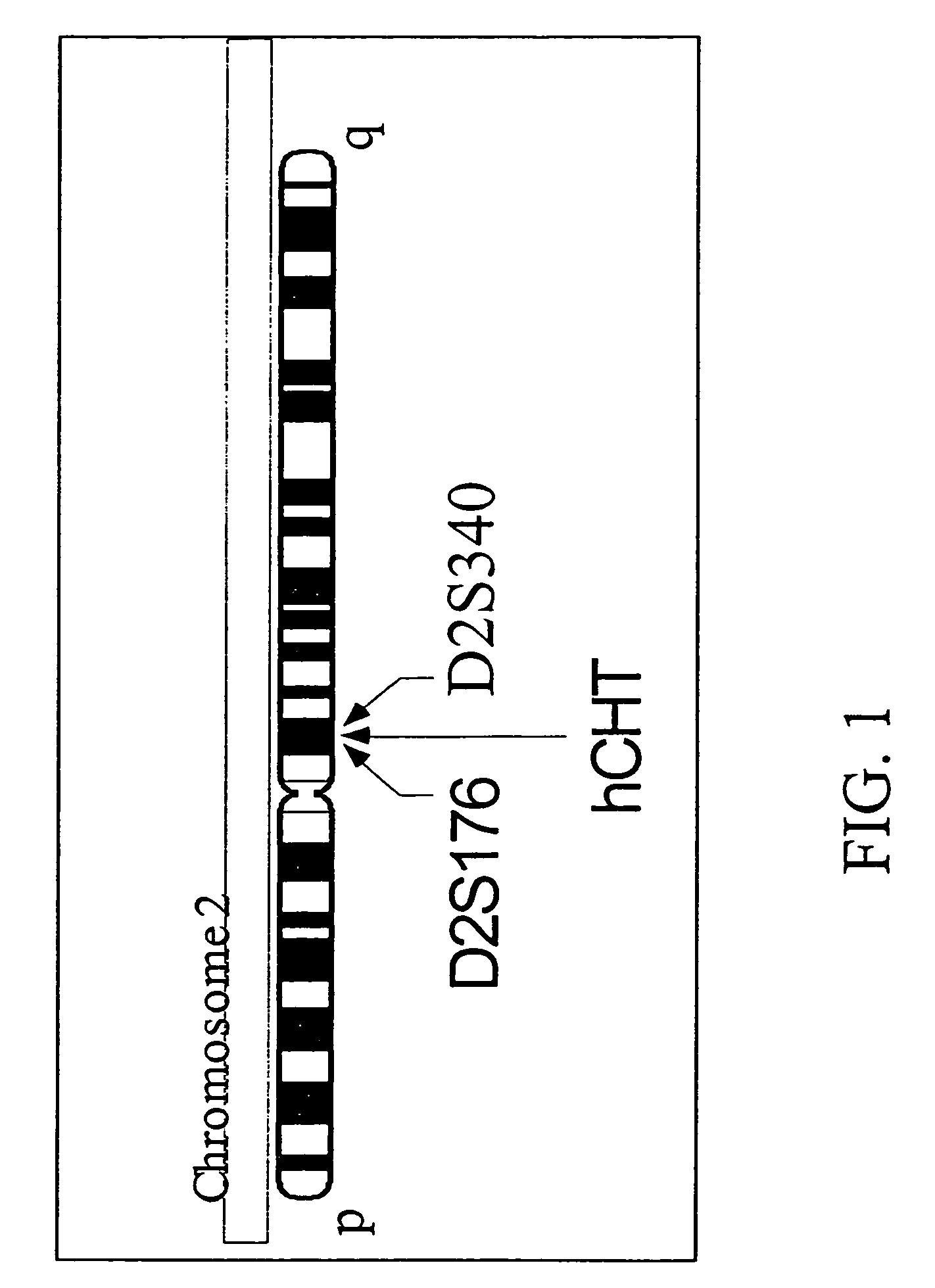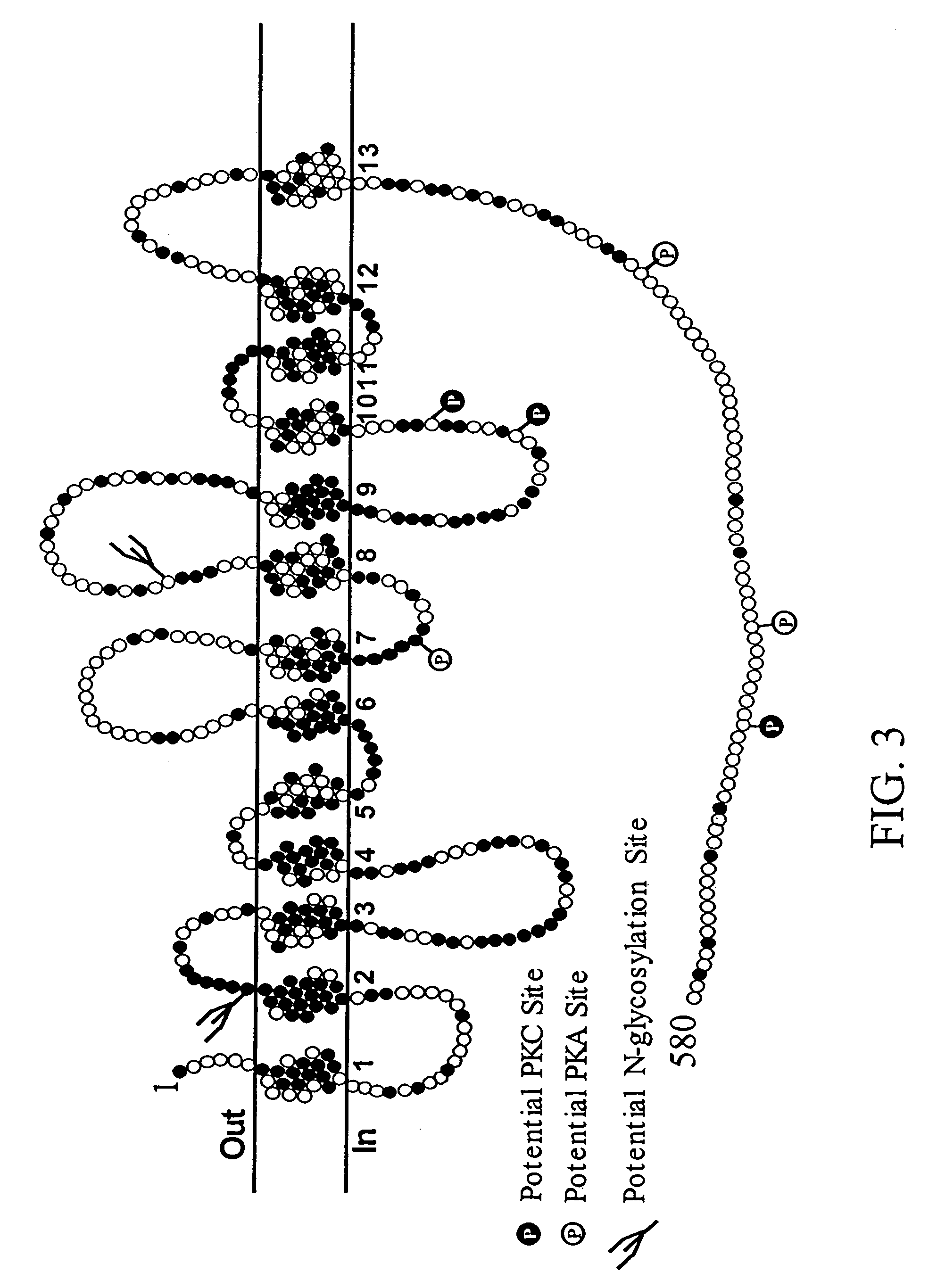Polynucleotide encoding a mouse choline transporter
a choline transporter and polynucleotide technology, applied in the field of pharmaceuticals, can solve the problems that the reagents developed to interfere or modulate the rat transporter may not be as clinically relevant as the reagents developed, and the lack of crossreactivity must be validated using less ideal tissue, so as to enhance the cholinergic signaling
- Summary
- Abstract
- Description
- Claims
- Application Information
AI Technical Summary
Benefits of technology
Problems solved by technology
Method used
Image
Examples
example 1
Cloning of hCHT cDNA
[0464]Based on the DNA sequence information obtained from the Human Genome Sequence Database and rCHT1 (SEQ ID NO: 5), genomic sequences (GenBank Accession Number AC009933, SEQ ID NO:13) predictive of a human homologue for rCHT were identified. Based on inferred coding exons, inventors designed non-degenerate oligonucleotide primers to isolate an hCHT cDNA (SEQ ID NO:1). The sense primer of SEQ ID NO: 15 (RB855, ATAAAAATGGCTTTCCATG-TGGAAGGACTG) overlaps the putative start codon and extends by 16 nucleotides on the 5′ end and 11 nucleotides on the 3′ end. The antisense primer of SEQ ID NO: 16 (RB852, TCACTGTAAATTATCTTCCAGTCCCAGACCC) overlaps the putative stop codon. hCHT cDNA was amplified by PCR (5 min at 95° C. followed by 35 cycles of 30 sec at 95° C., 30 sec at 60° C., and 4 min at 68° C. and finally a 7 min extension at 68° C.) using human spinal cord cDNA (Clontech) as template with Pfu Turbo DNA polymerase and the ProStar Ultra HF kit (Stratagene). The PCR ...
example 2
Cloning of mCHT cDNA
[0468]Degenerate oligonucleotides were used to amplify a 1780 bp product by RT-PCR from mouse spinal cord RNA. The PCR product comprises is what is expect for a full-length open reading frame for mCHT and exhibits a 98% nucleotide identity to rCHT1. BLAST analysis of the Celera Discovery System™ v3.01 mouse genomic DNA assembly using our mCHT cDNA yielded an identical sequence for the coding exons of mCHT and conserved intron / exon boundaries with the human CHT gene. The mCHT cDNA (GenBank accession number AF276872) encodes a protein of 580 amino acids and has a predicted mass of 63 kDa with a calculated isoelectric point of 4.9 (FIG. 2). Consistent with our predicted model for the secondary structure of hCHT (Apparsundaram et al., 2000) and the recently reported model for Limulus ChCoT (Wang et al., 2001), hydropathy analysis of mCHT amino acid sequence indicates the presence of 13 transmembrane domains (TMDs) with a short extracellular NH2 and large intracellula...
example 3
Chromosomal Localization
[0470]The chromosomal localization of the hCHT gene was determined by radiation hybrid mapping (Stewart, et al., 1997). Briefly, oligonucleotide primers were selected to amplify a 616 bp fragment of genomic DNA corresponding to a region that overlaps with the hCHT1 stop codon. The sense primer RB885 (5′-CTGTGTATGGGCTCTGGTA CC-3′; SEQ ID NO:16) is complementary to bases 1202-1220 of the hCHT coding sequence. The antisense primer of SEQ ID NO:17 (RB934, 5′-GCTGCATACCATCTCTCC-3′; SEQ ID NO:15) was designed based on analysis of the genomic sequence immediately 3′ from the hCHT stop codon (SEQ ID NO:19, GenBank Accession Number AC009963). PCR mapping with SEQ ID NOS: 17-18 was performed using the Stanford G3 Human / Hamster Radiation Hybrid panel (Research Genetics) as template. The PCR conditions were: 5 min at 95° C. followed by 35 cycles of 30 sec at 95° C., 30 sec at 60° C., and 30 sec at 72° C. and finally a 7 min extension at 72° C. PCR products were denatured...
PUM
| Property | Measurement | Unit |
|---|---|---|
| viscosity | aaaaa | aaaaa |
| viscosity | aaaaa | aaaaa |
| temperature | aaaaa | aaaaa |
Abstract
Description
Claims
Application Information
 Login to View More
Login to View More - R&D
- Intellectual Property
- Life Sciences
- Materials
- Tech Scout
- Unparalleled Data Quality
- Higher Quality Content
- 60% Fewer Hallucinations
Browse by: Latest US Patents, China's latest patents, Technical Efficacy Thesaurus, Application Domain, Technology Topic, Popular Technical Reports.
© 2025 PatSnap. All rights reserved.Legal|Privacy policy|Modern Slavery Act Transparency Statement|Sitemap|About US| Contact US: help@patsnap.com



